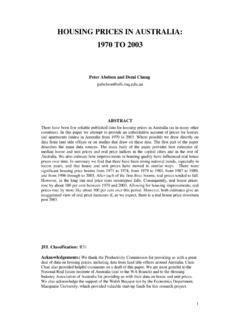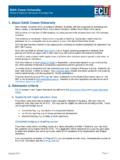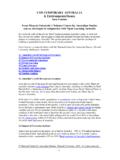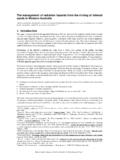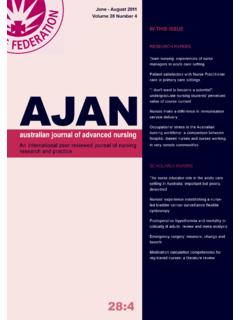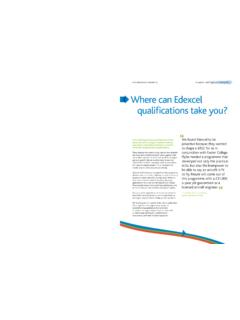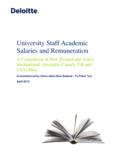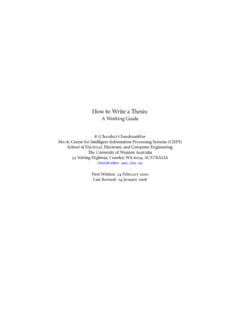Transcription of HOUSING PRICES IN AUSTRALIA: 1970 TO 2003
1 1 HOUSING PRICES IN australia : 1970 TO 2003 Peter Abelson and Demi Chung ABSTRACT There have been few reliable published data for HOUSING PRICES in australia (as in many other countries). In this paper we attempt to provide an authoritative account of PRICES for houses and apartments (units) in australia from 1970 to 2003. Where possible we draw directly on data from land title offices or on studies that draw on these data. The first part of the paper describes the main data sources. The main body of the paper provides best estimates of median house and unit PRICES and real price indices in the capital cities and in the rest of australia . We also estimate how improvements in HOUSING quality have influenced real house PRICES over time.
2 In summary we find that there have been strong national trends, especially in recent years, and that house and unit PRICES have moved in similar ways. There were significant HOUSING price booms from 1971 to 1974, from 1979 to 1981, from 1987 to 1989, and from 1996 through to 2003. After each of the first three booms, real PRICES tended to fall. However, in the long run real price rises outstripped falls. Consequently, real house PRICES rose by about 180 per cent between 1970 and 2003. Allowing for HOUSING improvements, real PRICES rose by more like about 100 per cent over this period. However, both estimates give an exaggerated view of real price increases if, as we expect, there is a real house price downturn post 2003.
3 JEL Classification: R31 Acknowledgements: We thank the Productivity Commission for providing us with a great deal of data on HOUSING PRICES , including data from land title offices around australia . Chris Chan also provided helpful comments on a draft of this paper. We are most grateful to the National Real Estate Institute of australia (and to the WA Branch) and to the HOUSING Industry Association of australia for providing us with their data on house and unit PRICES . We also acknowledge the support of the Walsh Bequest run by the Economics Department, Macquarie University, which provided valuable start-up funds for this research project. 2 1 Introduction As in many countries, there have been few reliable data on HOUSING PRICES in Until recently, public agencies published few data on HOUSING PRICES and private agencies filled the gap by drawing on their own partial and usually biased data sets of residential property sales.
4 Although the availability and quality of HOUSING price data have improved in the last 10 to 15 years, even today the Reserve Bank (2004) finds that the data are untimely and unreliable. In this paper we describe and assess the major sources of data on HOUSING PRICES since 1970, estimate price series for the major cities and for australia as a whole, and draw out the main findings about house and apartment (unit) PRICES . Section 2 describes the major data sources. Section 3 provides our estimates of median house and unit PRICES in the capital cities and in the rest of each state and the respective real price indices. We also estimate Australian indices for house and unit PRICES . Section 4 estimates the effects of improvements in HOUSING quality on house PRICES over time.
5 Section 5 summarises some major features of house and unit PRICES since 1970. A lengthy appendix provides detailed price data for each city and state from the alternative data sources. 2 Data Sources In australia in 2001, there were million residential dwellings of which 75 per cent were separate houses, 13 per cent were units and 12 per cent were other forms of HOUSING (terraces, semi-detached, town houses, etc.). Most HOUSING price data relate to houses; some to units; almost none to other dwellings. We describe below the main primary and secondary data sources. Primary sources There are three main primary sources of data on HOUSING PRICES : Government land title offices2, The Real Estate Institute of australia , and The Commonwealth Bank of australia .
6 1 We use the term HOUSING to refer to all forms of dwellings, including houses and apartments. 2 The location of the land title office varies according to the state or territory and may be in a Valuer-General Office, Department of Land, Department of HOUSING or some other Department. 3 Land title offices (LTOs) in all states and territories receive data on all property transactions based on settlement dates and are the best primary source of property price data. However, the LTOs vary greatly in their analysis and distribution of price data. Only the NSW LTO regularly publishes summary statistics on HOUSING PRICES ( ). Estimates of median PRICES now go back to 1980 but these data became available only recently.
7 The Victorian and South Australian LTOs can provide house price data from the early 1970s; the Northern Territory from 1980; Queensland from 1986; Western australia from However, most of these LTOs supply data to other parties only on a commercial and restricted basis. None publishes summary price statistics on a regular and timely basis. The tables in the Appendix show the price data available from LTOs. As indicated, some of the statistics shown are based on external analyses of land title data. It should also be noted that there are few LTO-based statistics for unit PRICES or for non-capital city PRICES . The second main source of primary data is the Real Estate Institute of australia (REIA).
8 The REIA has estimated median house and unit PRICES in most capital cities each quarter from 1980 and provided these estimates to its members and to others for non-commercial purposes. Before the September quarter 1998, these widely cited figures were based on sales that members reported to the state or territory branch of the REIA, again based on settlement dates. These were a large part of dwelling sales but not necessarily representative. However the bias, if any, in the data is not known. From September quarter 1998, the REIA reports that it has obtained most of its data from LTOs, except in Victoria where it still relies on sales recorded by REIA members (which range from 6,000 to 10,000 per quarter).
9 4 Thus the REIA is no longer a second primary source and its published series of dwelling PRICES is based on two different primary Since 1984, the Commonwealth Bank of australia (CBA) has estimated median house PRICES based on sales for which it provides finance in both capital cities and the rest of each state. Unlike the other two series, the PRICES are recorded when purchase is agreed rather than at settlement. The CBA figures are published regularly by the HOUSING Industry of australia . However, they are unlikely to be a representative set of houses. As will be seen, CBA HOUSING PRICES are often different from other price series. 3 We are not aware of any systematic analysis of ACT or Tasmanian land title data.
10 4 REIA statement in correspondence with authors. However, there are some differences between REIA estimates and government agency HOUSING PRICES supplied to us by the Productivity Commission. 5 Although drawing on the same primary data source, REIA estimates of median house PRICES are not always the same as other estimates that draw on land title data. 4 From time to time, there are other primary sources of HOUSING price data. A noteworthy example is the publication of the PRICES of auction sales in the 1960s and 1970s by some newspapers. Obviously price estimates derived from these sale figures may be poor guides to price levels, but perhaps less so as to percentage changes. However, they provided the basis of the major series of house PRICES estimated then by a consulting company (Bis-Shrapnel).
